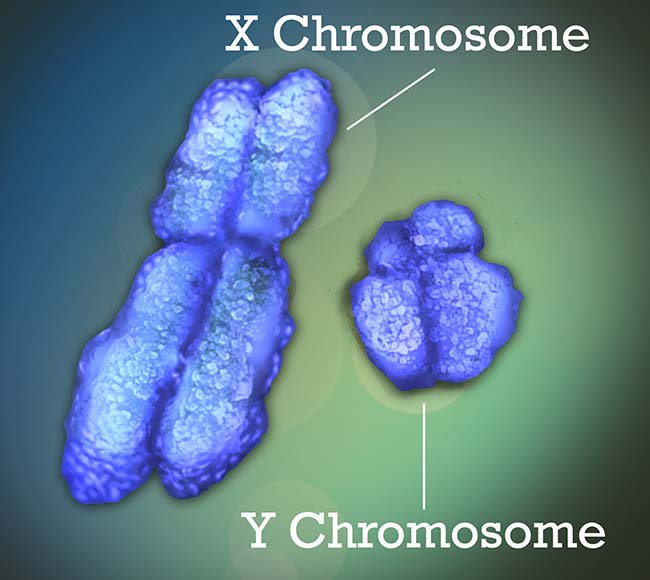The Y Chromosome: Beyond Gender Determination

- By Roseanne F. Zhao, Ph.D. - May 30, 2014
NIH M.D./Ph.D. Partnership Training Program Scholar
The human genome is organized into 23 pairs of chromosomes (22 pairs of autosomes and one pair of sex chromosomes), with each parent contributing one chromosome per pair. The X and Y chromosomes, also known as the sex chromosomes, determine the biological sex of an individual: females inherit an X chromosome from the father for a XX genotype, while males inherit a Y chromosome from the father for a XY genotype (mothers only pass on X chromosomes). The presence or absence of the Y chromosome is critical because it contains the genes necessary to override the biological default - female development - and cause the development of the male reproductive system.
Although the Y chromosome's role in sex determination is clear, research has shown that it is undergoing rapid evolutionary deterioration. Many generations ago the Y chromosome was large, and contained as many genes as the X chromosome. Now it is a fraction of its past size and contains fewer than 80 functional genes. This has led to debates and concerns over the years regarding the Y chromosome's eventual destiny. Many speculate that the Y chromosome has become superfluous and could completely decay within the next 10 million years. While studies of the Y chromosome have been challenging due to the palindromic and repeat-rich nature of its DNA sequence, recent genomic advances have provided some unexpected insights.
This installment of the Genome Advance of the Month highlights two studies published in the April 24, 2014, issue of Nature that explore the evolutionary path of the Y chromosome in various mammals. Together, these studies demonstrate the stability of the Y chromosome over the past 25 million years. They further reveal some critical functions of the Y chromosome that suggest it may be here to stay.
To get started, let's first delve into the evolutionary origin of the sex chromosomes, roughly 200-300 million years ago. The X and Y chromosomes, both of which derived from autosomes, were initially about the same size. At some specific time along the way, the Y chromosome gradually lost the ability to recombine - or exchange genetic information - with the X chromosome and began to evolve independently. This quickly led to a catastrophic deterioration of the Y chromosome, which now contains only 3 percent of the genes that it once shared with the X chromosome.
Recent work from the research groups of David C. Page, M.D., at the Whitehead Institute, Massachusetts Institute of Technology, and Henrik Kaessmann, Ph.D., at the Swiss Institute of Bioinformatics and the University of Lausanne in Switzerland, suggests that the initially rapid decline of the Y chromosome may have leveled off and stabilized.
Using different genomic technologies, these two research teams analyzed the evolution of the Y chromosome independently in two separate sets of mammals that covered more than 15 different species, including humans, chimpanzees, rhesus monkeys, bulls, marmosets, mice, rats, dogs and opossums. Strikingly, they found a small but stable group of essential regulatory genes on the Y chromosome that have endured over a long evolutionary period of time, even while surrounding genes were decaying. Significantly, these genes play a critically important role in governing the expression of other genes throughout the genome and may affect tissues throughout the human body. One of the reasons for the continued endurance of these regulatory Y chromosome genes is that they are "dosage-dependent," meaning that two copies are required for normal function.
For most genes on the X-chromosome, only one copy is required. Females have two X chromosomes and therefore two copies of every X-linked gene, so one copy is randomly inactivated, or turned off. Males have only one X chromosome and therefore only one copy is expressed.
However, regulatory genes are often dosage-dependent and haplo-insufficient, i.e., two copies of the gene are required and the presence of only one copy can lead to abnormalities or disease. In females, these regulatory genes escape X-inactivation so that the copy on the second X chromosome is also expressed; in males, who only have one X chromosome, the preservation of this group of regulatory genes on the Y chromosome is crucial for providing the second copy.
Overall, what this means is that beyond its role in sex determination and fertility, the Y chromosome also contains important genes that are critical for the health and survival of males.
These findings have considerable implications for our understanding of differences in biology, health and disease between men and women. Because genes on the X and Y chromosomes have a history of selection independent of each other, subtle functional differences may exist that are a direct consequence of genetic differences on the two chromosomes. While these differences have not yet been explored in great detail, more studies on the conserved Y chromosome genes can help us to understand differences in the basic biology and susceptibility to diseases in men and women and better guide health management.
Read the articles:
Bellott DW, Hughes JF, Skaletsky H, Brown LG, Pyntikova T, Cho TJ, Koutseva N, Zaghlul S, Graves T, Rock S, Kremitzki C, Fulton RS, Dugan S, Ding Y, Morton D, Khan Z, Lewis L, Buhay C, Wang Q, Watt J, Holder M, Lee S, Nazareth L, Rozen S, Muzny DM, Warren WC, Gibbs RA, Wilson RK, Page DC. Mammalian Y chromosomes retain widely expressed dosage-sensitive regulators. Nature, 508(7497):494-9. 2014. [PubMed]
Cortez D, Marin R, Toledo-Flores D, Froidevaux L, Liechti A, Waters PD, Grützner F, Kaessmann H. Origins and functional evolution of Y chromosomes across mammals. Nature, 508(7497):488-93. 2014. [PubMed] - https://www.genome.gov/27557513


